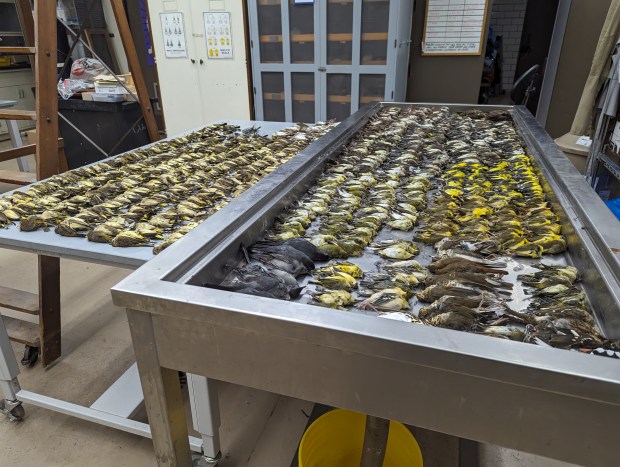After nearly 1,000 birds crashed into McCormick Place Lakeside Center last October, the event space along Lake Michigan’s shoreline is installing a gridded window film to mitigate future collisions.
The $1.2 million project began the first week of June and is expected to conclude by early September, just in time for the fall migration.
Located along a major route for birds flying between South America and North America, Chicago — with its glass buildings and lakefront — is one of the deadliest cities for migrating birds. And, the Lakeside Center, which has two football fields worth of windows, “has perhaps been Chicago’s most dangerous building since it was built in the ‘70s,” said Annette Prince, director of Chicago Bird Collision Monitors.
Birds struggle to perceive clear glass. Instead, they see their habitats reflected back to them and fly into windows. Buildings along the city’s shoreline are particularly dangerous because they are the first structures birds encounter after stretches of open air, and water creates a striking reflection on glass.
The films being installed at the center are etched with tiny dots that make it easier for birds to distinguish windows from the outdoors.
Chicago Bird Collison Monitors, a nonprofit advocacy group, has been campaigning for these bird protection measures for several years. But, Prince said the building owner, Metropolitan Pier and Exposition Authority, ignored them until October’s mass casualty event, which made national news and got the attention of the U.S. Fish and Wildlife Service.
The event has frequently been reported alongside a 2019 study that found a “staggering” 29% population decline in North American birds since 1970.
Climate change and human activity — which includes building collisions — were among the contributing factors identified in the study. And, the October mass collision followed a series of unfavorable, strong weather conditions that forced many birds to fly the same path at the same time.
Bird safety measures have also gotten more attention from the Chicago Department of Planning and Development recently. A revised sustainable development policy for city-assisted construction and rehabilitation projects tripled the weight given to the inclusion of bird protection measures in project plans.
However, local bird advocacy groups say incentives aren’t enough. They would like to see bird protection required on all new and renovated buildings.
“Fire extinguishers, sprinkler systems, handicap accessibility … we don’t let those things be optional. We say this will affect somebody’s ability to be safe,” said Prince. “And these bird protection measures will decide whether a building kills 1,000 birds or not.”
Her organization has joined with others to craft language for an ordinance that would require anti-collision films on all new buildings and major renovations.
“It’s very difficult for birds to speak about how important those are, and so we feel like we’re the ones who have to get that message across,” said Matt Igleski, executive director of the Chicago Bird Alliance.
New York City, Washington, D.C., and Evanston enacted similar bird protection requirements within the last four years.
As it works on proposals for the Chicago ordinance, Chicago Bird Collection Monitors has been lobbying for Bally’s Casino to incorporate window films into its planned complex along Chicago’s riverfront.
The latest renderings of the casino complex reveal sweeping glass facades that will reflect the water like the Lakeside Center.
“We do not want to see massive bird kills along the Chicago River. (Bally’s) seemed to be receptive to that idea,” said Prince. But, she has yet to hear if any anti-collision technology will be in the casino’s final plans.
Representatives from Bally’s could not be immediately reached for comment.
But, reflections off the windows are only half the problem in big cities, Igleski said.
Birds are also attracted to interior lights at night. And, many that migrate through Chicago, such as warblers, sparrows and vireos, travel at night.

Turning just half of the Lakeside Center’s lights off during spring and fall migrations could reduce fatal bird collisions by 60%, according to a 2019 study.
This solution, however, requires a change in human behavior — turning off lights — which is harder to enforce with an ordinance or encourage with policy incentives than installing window treatments, said Igleski.
McCormick Place frequently has evening events that necessitate some lights on after dark, but drapes are being closed where available and lights are being turned off when possible, said a spokesperson for the building.
“We’re really thankful and appreciative that they’re responding and we hope that they can be a good example of what buildings can do in the city to help mitigate bird collisions,” said Igleski.





